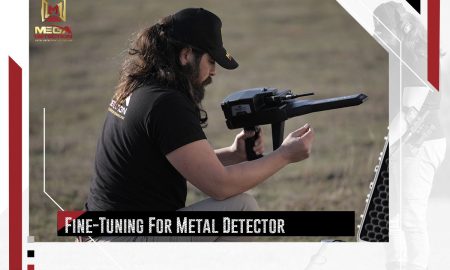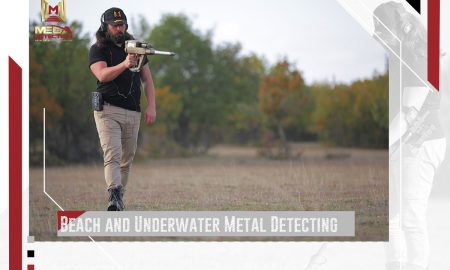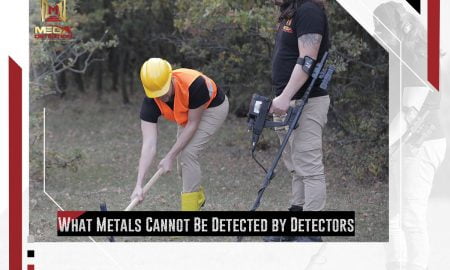Find Gold With VLF Detectors
Find Gold With VLF Detectors
Whether you’re looking for gold deposits or ancient gold coins left by a forgotten civilization that may have lived in your area, an efficient VLF detector can go a long way. It’s always a good idea to start with some basics on VLF. That way, you have some ground to start working with, especially if you’re in the market for one.
VLF is an abbreviation for Very Low Frequency. It refers to the frequency of single-frequency sine waves transmitted at high-pitched audio frequencies. In metal detecting “low” is between 3 kHz and 30 kHz. VLF are usually better for finding gold in most conditions. Pulse Induction (PI) work a little better in highly mineralized soil and saltwater.
Where Are the Best Places to Find Gold?
Experts recommend hillsides. Hillsides will yield a better result when it comes to finding gold. Another reason why hillsides are so great is that if you find the source of the gold deposit, you can find the veins.
The veins tend to have more extensive gold deposits. The larger the deposit, the easier it is to find the gold. Unfortunately, gold is a scarce mineral. Not only that, but you will find it in much smaller deposits compared to other minerals like metal.
Before getting into the best VLF for gold, it’s essential to understand a couple of things about VLF detectors.
Manufacturers make metal detectors to find gold; pretty much all of them can do that. The answer to this concern lies in the different sensitivity levels that every single VLF detector has. Experts recommend getting a VLF detector that has a high sensitivity level.
Experts recommend an operating frequency of between 13 kHz to 19 kHz. It’s the minimum frequency level for detecting gold and anything higher is another excellent prospect.
Experts also recommend a VLF detectors with manual ground balancing. This feature is crucial if you want to drown out ground noise while in use. It’s a bit complex, and so some users prefer an automated ground balancing system.
Types Of Gold Detectors
Gold prospectors have two basic choices when metal detecting for gold. There are very-low frequency (VLF) metal detectors, and there are pulse-induction (PI) metal detectors. Both types can find gold, and each has their own place in the goldfields.
These two detector types each have advantages and disadvantages, but most serious gold hunters have gravitated toward PI detectors in recent years. And this is for good reason… PI detectors run much quieter and smoother than VLF detectors. They do an exceptional job of canceling out hot rocks and ground noise, which VLFs aren’t so good at.
I use a PI detector for about 90% of my gold detecting. Their ability to cut through the ground noise gives them a considerable depth advantage over VLF detectors. Of course depth is very important in many places, because the goldfields have been hunted hard over the years. If you are hunting in a “pounded” out area, then a tiny extra bit of depth can result in a nice nugget that other detectors can’t hear.
Pretty much every serious gold hunter I know is using both a PI and VLF detector. PI detectors are still the go-to detector for most situations because of their depth advantages, but don’t throw away those VLF detectors just yet.
VLFs are much older technology. Lots of the better-known goldfields were already “cleaned out” with VLF detectors before PI detectors were even invented. Then PI detectors came along (over 20 years ago now) and prospectors were able rework old areas again.
In these heavily worked areas, you would think that a VLF detector would be about worthless. However, they still have some advantages over PI detectors that will produce gold even to this day. Even those $5,000 PI detectors will miss gold that you can only find with a VLF.
VLFs are still better than PI detectors when it comes to small gold. PI detectors are great for punching deep on good-sized nuggets, but they aren’t all that great on small bits of gold. This is especially true on flaky, crystalline pieces of gold. For some reason, these nuggets can be virtually “invisible” to PI detectors.
Some of the newer PI detectors have improved considerably and hit really well on smaller gold, but VLFs are still king.
Metal Detector Discrimination
All VLFs have discrimination capabilities that give you an idea of what’s in the ground before you dig. This can be helpful, but I recommend you dig all targets most of the time. Once you really understand your detector you can pass on some targets, but most of the time I’d tell you to dig.
How Does Metal Detector Discrimination Work?
It is important to note that while most any VLF (Very Low Frequency) will come equipped with DISC features, PI (Pulse Induction) metal detectors have no discrimination capabilities. This shouldn’t be an issue for most users as PI metal detectors are often expensive in comparison to VLF metal detectors and therefor only purchased by users who would already know that PI metal detectors don’t have discrimination. However, this information should be in the description of the metal detector if you are unsure.
VLF metal detectors work by sending a constant alternating current through a coil which, due to the polarity being reversed thousands of times per second, creates a transmit frequency that is sent into the ground. If this transmit signal encounters metal, a signal which is opposite in polarity to the transmit coil is produced within the object. These currents are known as eddy currents and are a natural response to a metallic object encountering a magnetic field.
DISC works through the same process by which normal metal detection does. The eddy currents produced within the object are first detected by a second coil. These signals are then processed and then amplified to create the sound which lets you know metal has been detected. DISC simply intervenes during the processing of these signals and tells the alert device on the metal detector to ignore certain frequencies or prioritize others.
What is the Difference Between Metal Detector Discrimination and Sensitivity?
While DISC deals with processing signals to determine an objects metallic composition, metal detector sensitivity is simply changing how strong (or rather weak) a signal your metal detector will accept. This means that by increasing your metal detectors sensitivity you may be able to detect objects which are non-ferrous metallic or simply deeper in the ground. While this can be used, in some degree, to exclude certain types of metal it is nowhere near as comprehensive or easy to use as the DISC function. It is for this reason that the two functions are separate and are deemed to have separate purposes.
Using Metal Detector Discrimination to Eliminate Ground Mineralization Interference
Different hunting locations will have different kinds and compositions of soil. In some cases, you will encounter soil which is rich with ferrous minerals that generate eddy currents of their own when affected by a metal detectors signal. While it is unlikely that these signals will be strong enough to elicit an audible response from your metal detector, their effects are not undetected. These signals from the minerals in the soil can overload a metal detectors RX coil with useless target allocation even if a real target is in range of the coil’s detection field.
However, to eliminate these signals from your detection array you simply need to discriminate against Iron signals altogether. Most targets of value will not be affected as Iron is a low value non-precious construction material. In highly mineralized soil, Iron discrimination won’t be perfect but will be undoubtedly useful for finding targets and elimination phantom hits.
The depth of an object, along with the chosen level of sensitivity, can affect which type of metal an object is identified to be by your metal detectors DISC circuit. If an object is detected from the outer edge of a magnetic field then only a portion of the magnetic field will be processed by your metal detectors elimination circuit. Unfortunately, this can result in your metal detector confusing one metal for another which has a similar DISC ID.
For a similar reason to why depth can affect DISC ID, the size of an object will also change DISC ID. Essentially, the larger an object is the greater the signal from internal eddy currents will be. The stronger a signal is the easier it is for your metal detectors DISC circuit to determine metallic composition.
So, it would stand to reason that a smaller target, coupled with low sensitivity, could create a very weak signal. The weak signal a small object produces is no different than a very deep object and therefor will have similar characteristics. This means that the object could have: an incorrectly reported DISC ID, a low and unreliable tone, or even an inability to be detected.
The only metal which is unaffected by surface oxidation is gold and various gold-alloys. Everything else is prone to an unavoidable, and inevitable, oxidation. Oxidation, more commonly known as rusting, happens when a reactive element is exposed to oxygen. In this case it is the production of a myriad of metallic-oxides which we are concerned with.
Metallic-oxides which are produced from corroding objects will bleed into the surrounding soil when moisture is present. This is more commonly known as the halo-effect. It is referred to as the halo effect because a targets field of detection will increase in a radiating pattern around the object.
If the soil which you are hunting in is moist, then the halo-effect can be your best friend. Allowing you to easily find smaller and deeper targets which have had their detection fields increased. However, these metallic-oxides will produce different DISC ID’s which might be discriminated against if you are excluding Iron or even Tin.
Due to the copious amounts of information modern metal detectors can gather and process, even the orientation of an object, in the ground, can affect DISC ID. A perfect example of this is that of the orientation of a coin. A coin may have a strong signal if it is positioned with the flat side parallel to the metal detector coil. A coin may also have a very weak signal if the flat side is positioned perpendicular to the metal detector coil.
The difference in the strengths of these two signals affects DISC ID in a similar way as both depth and size previously have. If the coin is positioned perpendicular to the coil: the DISC ID could be incorrectly reported, a low and unreliable signal can be detected, and in some cases an object will be completely unable to be detected.
Many beginners may find it useful to gain experience from finding various pop can pull-tabs, nails, and other low value high presence objects. Finding these objects can teach a beginner how to use the pin pointer function of a metal detector and how to properly dig for an object. It is in this case that is in fact useful to not use any form of metal DISC.
If you are a beginner but you don’t care much for gaining experience, and instead favor finding only valuable targets, DISC can be incredibly valuable. Without the experience and know-how of an advanced user, a beginner can relatively easily find coins, rings, and other valuable objects. All of this while not being bogged down by constantly finding junk.
In either case, to ensure the value of your choice to, or to not, discriminate for or against certain metals, it is important to become familiar with both the discrimination and sensitivity settings of your specific metal detector.












Leave a Reply